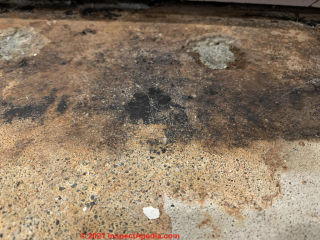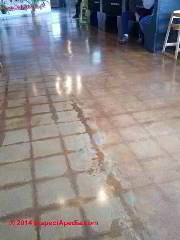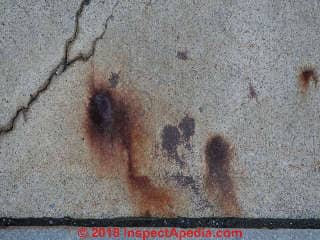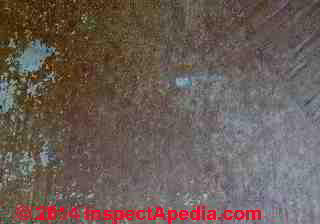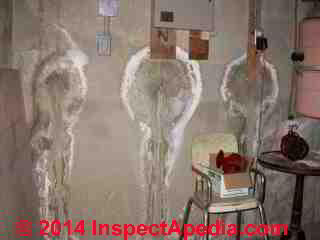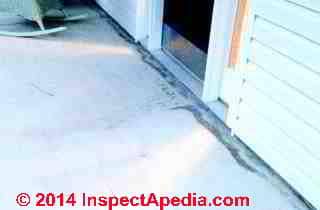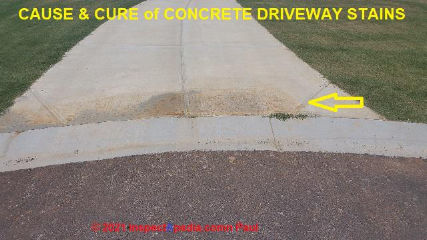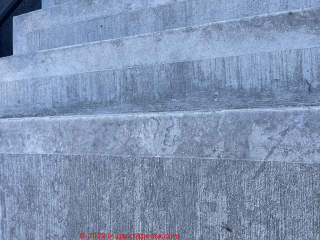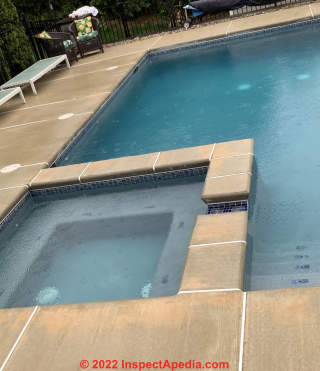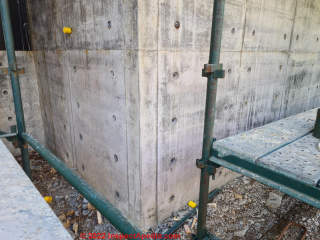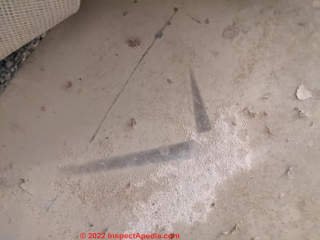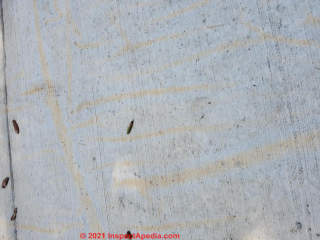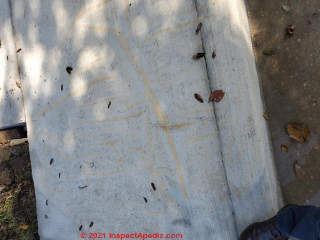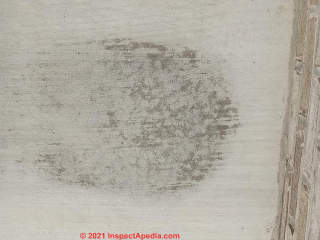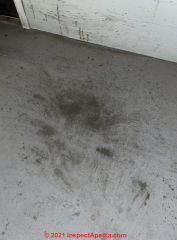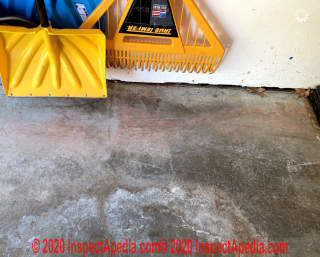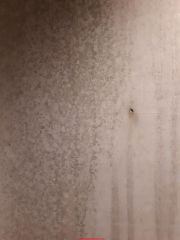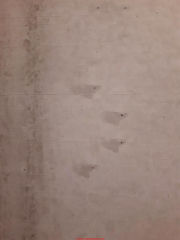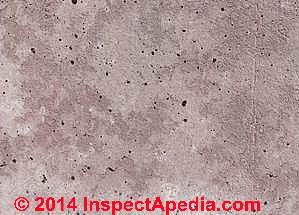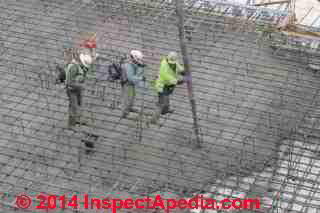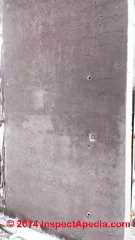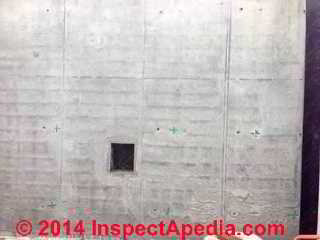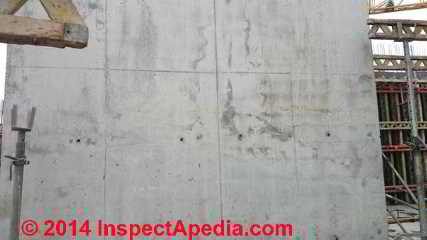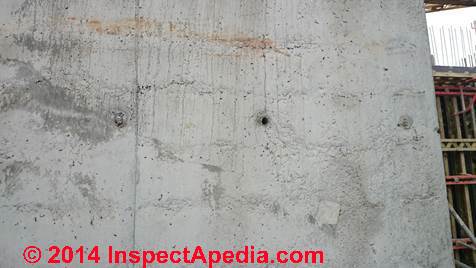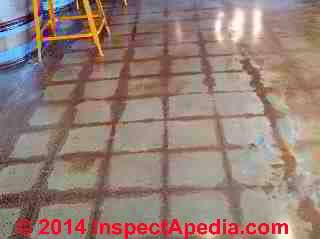 Stains on Concrete
Stains on Concrete
Types & sources of stains on concrete surfaces & stain removal
- POST a QUESTION or COMMENT about stains found on concrete surfaces: walls, floors, ceilings
Un-wanted stains & colors or discoloration & defects on concrete surfaces:
This article provides a catalog of types of stains found on concrete surfaces: walls, floors, ceilings, including un-wanted stains from various causes & deliberate concrete coloring processes, stains, or acid treatments.
Methods for removing un-wanted discoloration or stains from concrete. Catalog of research on causes & cures of concrete staining. Concrete stain products & product sources are also provided.
InspectAPedia tolerates no conflicts of interest. We have no relationship with advertisers, products, or services discussed at this website.
- Daniel Friedman, Publisher/Editor/Author - See WHO ARE WE?
Concrete Surface Stains, Diagnosis, Causes, Cures & Concrete Coloring Products
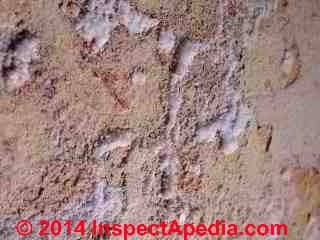 Catalog Of Sources of Concrete Colors, Marks, Stains & Staining or Discoloration
Catalog Of Sources of Concrete Colors, Marks, Stains & Staining or Discoloration
[Click to enlarge any image]
Before reviewing the types and causes of stains, discoloration, or defects in concrete surfaces, did you intend to read about how we deliberately color or stain concrete?
If so, see CONCRETE COLORING & POLISHING - how color is applied to concrete floors & other surfaces. Else please continue below.
Watch out: in order to have a chance of success at removing stains or discoloration on or in concrete, it is important to first make a best-effort to identify the type of stain or its source. As you'll read in the detailed concrete stain removal guides found on this page, the stain removal treatment that will work depends on the chemistry or cause or source of the stain on concrete.
Stains on concrete sidewalks, porches, or interior concrete floors may be ascribed to a variety of sources that we list here. We categorize concrete stains and discolorations in these groups:
- Biological stains on concrete
caused by algal growth, fungal growth, and other sources.
See - Brown & Black stains on concrete - from leaks or spills
like those in the photo below are most-often caused by leaks, spills, petroleum products, possibly also building fires
A number of sources can produce the mix of very dark black and brown stains ranging to lighter brown stains on a concrete floor or possibly a wall, as shown below in this photo from InspectApedia reader Noah Davis.
The concrete stains shown below are on an interior concrete floor below-grade, in a 1919 Seattle home.
Common causes of dark stains like this besides a spill of oil or grease include leaks that leach out creosote from wood framing, oil or asphalt or grease spills or leaks nearby, even outside the building, and on occasion we see shiny hard black and brown stains on concrete following a building fire, as products of combustion, combined with water from efforts to put out the fire, form a glazed stain.
The concrete floor staining above is discussed
at CONCRETE STAINS, BLACK, BROWN, TAN where we show more photos of this interior concrete floor.
- Concrete discoloration associated with the concrete mix,
pour, or pour conditions. Examples include- CONCRETE COLD POUR JOINTS
- Concrete spalling or cracks leading to leak stains due to freezing
FREEZING & WATER DAMAGED SLABS or improper mixing or improper ingredients
- Concrete discoloration associated with materials left on the concrete surface
Where rubber or plastic mats or containers are left on a concrete surface, particularly outdoors or in a garage, plasticizers in the rubber or plastic material can cause changes in the color of the concrete under the item or material. For example a concerte slab that has been deliberately stained or treated to achieve a desired color may appear lighter where a doormat or plastic storage box has been left in place for some time.
Similarly, lumber or other stored materials left on a concrete driveway can hold moisture in the area below the stored items, leading to differences in concrete color - darker due to moisture, lighter due to formation of mineral salts (effloresence), or even other colors that might bleed out of the stored materials onto the concrete surface. - Concrete discoloration due to contaminants seeping up from below
Contaminants under a concrete walk or slab can seep to the surface causing discoloration that will vary depending on the chemistry of the contaminant itself, such as heating oil or sewage leaking ujp from below.
- Concrete stains or colour variations associated with finishing details
or variations such as extent of trowel work or hard finishing. See this PHOTO of black mottled stains around a heating system oil line set.
- Concrete stains associated with spills or leaks,
such as a sewage backup or oil spill, even spilling of a cleaner or other chemical or solvent.
The stains shown in our photo above (a restaurant in Poughkeepsie, NY, USA) are characteristic of vinyl-asbestos or asphalt asbestos floor tile mastic or adhesive that was removed during building renovation.
The concrete was cleaned, polished, and coated with a clear sealant, leaving the telltale but accidental staining that marks the pattern of original floor tiles. - Concrete stains associated with bleed-through
of substances from other sources such as contaminants outside a foundation wall, insulating or expansion joint materials at the perimeter of a slab,oil leaks from an outdoor oil storage tank or vehicle.
- Concrete Stains and Cracking associated with rusting iron or steel
or slag steel inclusions in the concrete material, either by deliberate inclusion as reinforcement, or by accident such as stones or scrap containing iron that are later exposed to water and possibly freezing cycles.
Our red rust stains on the concrete sidewalk shown above were found on the Vassar College campus in Poughkeepsie NY.
Watch out: rusting and exfoliation of iron inclusions in poured concret re structures can lead to very costly damage.
In the U.K. in Cornwall and Devon between 1900 and 1950 and more-recently in the U.S. in homes built in the 1980s, pyrrhotite-contaminated concrete in the Connecticut has been blamed on a significant number of concrete cracking failure.
Details are at FOUNDATION DAMAGE by MATERIAL or INCLUSIONS
- Concrete stains on painted concrete surfaces,
such as mold growth on painted concrete; mold may also grow even on bare concrete where organic dust and debris have accumulated (dogs living in the un-finished basement).
See MOLD on CONCRETE, STONE or MASONRY SURFACES - Deliberate stains or colors applied to concrete floor slabs
as a finish treatment using acid treatments or paint-on stain colours.
In our photo below the variations in gray color of the interior hard-finished floor are within normal occurrence on a hard-finished concrete floor slab of this Tivoli, New York home.
See CONCRETE COLORING & POLISHING for details.
Below: the concrete floor was "stained" using an acid treatment. The light patches in the left of the photo indicate foot-traffic wear through the acid-treated concrete surface . (Rigby 2006).
Wear on a stained concrete floor will be increased by any of the following
- Foot traffic, especially if there is grit tracked onto or present on the stained concrete floor surface
- Wear caused by hard wheels on office chairs, library carts, trolleys, or other rolling equipment
- Moisture penetrating the concrete floor from below
- Moisture left atop the sealed floor
- Spills of solvents or acids that damage the protective coating
- Poor original concrete mix or placement or excessive water in the pour that yields a soft, spalling surface
- Concrete stains associated with moisture - white or dark stains on concrete surfaces.
such as foundation leaks or moisture below floor slabs.
Even if we do not see actual water on the concrete floor or slab surface, variations in moisture sources below the slab can create dark areas of higher moisture.
The white and gray stains shown on the poured concrete basement wall at left are due to water and moisture seeping through the wall at concrete form ties that were not adequately sealed on the wall exterior after initial construction.
See these diagnostic articles
Dark Stains on Concrete: chronic moisture
Reader Question: what are these black stains on our concrete porch?
4/1/2014 AUTHOR:Rhonda (no email)
COMMENT: I have a problem with my front porch, it runs the whole length of the porch, tried pressure washing it, it didn't come off and seemed to make it worse.
Reply:
Rhonda, the black marks in your photo (shown here so that others may comment) may be due to moisture variations in the slab, moisture from below, or moisture entering the house-slab juncture, possibly bearing staining contaminants.
But most likely we're looking at a combination of variation in concrete hardness and moisture level.
The observation of those round-ish blot stains on the concrete slab surface in front of the entry door
suggest that a door mat was placed there previously, holding moisture in the slab (possibly during curing). Does the stain pattern vary with dry weather?
This comment was originally posted at MOLD APPEARANCE - STUFF THAT IS NOT MOLD
Stains on New Concrete Drive May be due to Concrete Additive
The stained area at this concrete drive entry were ultimately traced to possible inadequate mix of a cold-weather accelerator (CaCl) added to the concrete during concrete placement.
A detailed discussion of the history, diagnosis, and final concrete contractor repair proposal are found
at EFFLORESCENCE & BROWN DEPOSITS
Research References: Stains & Stain Removal Methods on Concrete Surfaces
Causes Of & Cures For Stains on concrete: diagnosis & removal of stains & discoloration
Watch out: some of the cleaners, poultices and other methods described for removing stains from concrete involve dangerous chemicals.
Do not attempt to follow those procedures if you are not properly equipped with personal protective equipment, have protected surrounding materials from damage, and are trained in safe or professional procedures for handling these chemicals and cleaners.
-
ASBESTOS ENCAPSULANTS & SEALERS [Web Article] Sealant Paints & Coatings for Asbestos, Asbestos Cement or Transite Surfaces - Some of these sealants will bond to and seal contaminated concrete surfaces and can seal surface deposits of asphalt mastic and some other hard-to-remove contaminants on concrete floors.
Really? As long as there is no water or moisture problem in the slab, a coating can leave the floor ready for any other covering, even mastic- or glued-down floor tiles or other surfaces you may want to install.
- Anastasiou, E., and I. Papayianni. "Criteria for the use of steel slag aggregates in concrete." In Measuring, Monitoring and Modeling Concrete Properties, pp. 419-426. Springer Netherlands, 2006.
- Broomfield, John P. Corrosion of steel in concrete: understanding, investigation and repair. CRC Press, 2002.
- Chew, Michael YL, and Phay Ping Tan. Staining of facades. Singapore: World Scientific, 2003.
- De Muynck, Willem, Anibal Maury Ramirez, Nele De Belie, and Willy Verstraete. "Evaluation of strategies to prevent algal fouling on white architectural and cellular concrete." International Biodeterioration & Biodegradation 63, no. 6 (2009): 679-689.
- Dubosc, A., G. Escadeillas, and P. J. Blanc. "Characterization of biological stains on external concrete walls and influence of concrete as underlying material." Cement and Concrete Research 31, no. 11 (2001): 1613-1617.
- Escadeillas, Gilles, Alexandra Bertron, Erick Ringot, Philippe J. Blanc, and Arnaud Dubosc. "Accelerated testing of biological stain growth on external concrete walls. Part 2: Quantification of growths." Materials and structures 42, no. 7 (2009): 937-945.
- Escadeillas, Gilles, Alexandra Bertron, Philippe Blanc, and Arnaud Dubosc. "Accelerated testing of biological stain growth on external concrete walls. Part 1: Development of the growth tests." Materials and structures 40, no. 10 (2007): 1061-1071.
- Gaudette, Paul & Deborah Slaton, PRESERVATION of HISTORIC CONCRETE [PDF] (2007) US NPS, Preservation Brief No. 15, retrieved 2022/10/06, original source: https://www.nps.gov/tps/how-to-preserve/briefs/15-concrete.htm
Excerpts:
Staining of the concrete surface can be related to soiling from atmospheric pollutants or other contaminants, dirt accumulation, and the presence of organic growth.
However, stains can also indicate more serious underlying problems, such as corrosion of embedded reinforcing steel, improper previous surface treatments, alkali-aggregate reaction, or efflorescence, the deposition of soluble salts on the surface of the concrete as a result of water migration (Figure 15) [shown above]
Characteristic signs of failure in concrete include cracking, spalling, staining, and deflection.
... Other signs of corrosion of embedded steel include delamination of the concrete (planar separations parallel to the surface) and rust staining (often a precursor to spalling) on the concrete near the steel.
...
Chemical surface treatments can clean effectively but may also alter the appearance of the concrete by bleaching the concrete, removing the paste, etching the aggregate, or otherwise altering the surface.
Detergent cleaners or mild, diluted acid cleaners may be appropriate for removal of staining or severe soiling.
Cleaning products that contain strong acids such as hydrochloric (muriatic) or hydrofluoric acid, which will damage concrete and are harmful to persons, animals, site features, and the environment, should not be used.
...
Some silicone sealants may stain adjacent materials, which may be a problem with more porous concrete, and may also tend to accumulate dust and dirt.
Gaudette, Paul, PRESERVATION of HISTORIC CONCRETE [PDF] (2000) older print edition, original source: nps.gov/orgs/1739/upload/preservation-brief-15-concrete.pdf
Paul Gaudette is an engineer with Wiss, Janney, Elstner Associates, Inc., in Chicago, Illinois. Deborah Slaton is an architectural conservator with Wiss, Janney, Elstner Associates, Inc., in Northbrook, Illinois. All photographs by Paul Gaudette unless otherwise stated. - Harrison, D. "The Removal of Stains from Concrete." Ontario Hydro Research News (1959): 19-24.
- Higgins, D. D. Removal of stains and growths from concrete. No. Monograph. 1982.
- Hurd, M. K. "Cleaning concrete." Concrete Construction 37, no. 11 (1992): 791.
- Kosmatka, Steve. Discoloration of Concrete, Causes and Remedies. Concrete Products, April, 1987.
- Kuenning, WH, Removing stains from concrete. Aberdeen Group, 1993.
- Kuenning, W. "Methods of removing some specific stains from concrete: Oil to Wood." [PDF]
- Mindess, Sidney, and James C. Gilley. "The staining of concrete by an alkali—Aggregate reaction." Cement and Concrete Research 3, no. 6 (1973): 821-828.
- PYRRHOTITE INCLUSION CRACKING [Web Article] - iron and sulfur damage to foundations may include stains or may show up as extensive cracking in poured concrete
- Ramachandran, Vangipuram Seshachar, and J. Beaudoin. "Removal of stains from concrete surfaces." Canadian Building Digest (1973): 1-4.
- de Rincón, O. TROCONIS, A. ROMERO de Carruyo, D. Romero, and E. Cuica. "Evaluation of the effect of oxidation products of aluminum sacrificial anodes in reinforced concrete structures." Corrosion 48, no. 11 (1992): 960-967.
- Uemoto, T. "Maintenance of concrete structure and application of non-destructive inspection in Japan." Proc. Non Destructive testing in Civil Eng (2000): 1-11.
- U.S. GSA MAKING A SOLUTION FOR REMOVING BEVERAGE, SOOT, TAR AND OTHER STAINS FROM CONCRETE [PDF] retrieved 2020/12/14
- U.S. GSA MAKING JAVELLE WATER [PDF] retrieved 2020/12/14 original source: https://www.gsa.gov /technical-procedures/ making-solution-removing-beverage-soot-tar-and-other-stains-concrete?Form_Load=88407
Excerpts:
Javelle water is recommended for use in removal of the following stains:
Beverage stains (see also "Removing Beverage Stains from Concrete").
Fire, smoke, soot, pitch and wood tar stains (see also "Removing Fire, Smoke, Soot, Pitch And Wood Tar Stains From Concrete").
Ink stains (see also "Poulticing Ink Stains From Concrete").
Perspiration stains (see also "Poulticing Perspiration Stains from Concrete").
Plywood or joint sealant stains (see also "Poulticing Plywood or Joint Sealant Stains from Concrete").
Tobacco stains (see also "Removing Tobacco Stains from Concrete").
Paraphrasing: Javelle water is a mixture of Calcium Hypochlorite (CaCl2O2), Sodium Carbonate (Na2CO3), and clean potable water. - U.S. GSA POULTICING BRONZE AND COPPER STAINS FROM CONCRETE [PDF] retrieved 2020/12/14
Excerpt:
Green stains on concrete, and sometimes brown stains, are common where water has flowed over copper or bronze. - U.S. GSA POULTICING CURING COMPOUND STAINS FROM CONCRETE [PDF] retrieved 2020/12/14
Excerpt:
Curing compounds often disappear from concrete with the effects of natural weathering. However, if this is not aesthetically acceptable, chemical agents may be used to assist in stain removal. - U.S. GSA POULTICING INK STAINS FROM CONCRETE [PDF] retrieved 2020/12/14
Excerpt:
This procedure includes guidance on removing various types of ink stains from concrete by poulticing. - U.S. GSA POULTICING IODINE STAINS FROM CONCRETE [PDF] retrieved 2020/12/14
Excerpt:
Iodine stains generally fade and disappear [from concrete] with time. However, if immediate removal is desired, a poultice containing denatured alcohol may be used in stain removal. - U.S. GSA POULTICING IRON RUST STAINS FROM CONCRETE [PDF] retrieved 2020/12/14
Excerpts:
This procedure includes guidance on removing both surface and penetrating rust stains from concrete by poulticing with chemical solvents.
Stains of a rust color on concrete are usually caused by rusting of steel in or on concrete, from use of curing water that contains iron in solution or from pyrites (iron sulfide particles) occasionally found in aggregate. - U.S. GSA POULTICING LINSEED, SOYBEAN AND TUNG OIL STAINS FROM CONCRETE [PDF] retrieved 2020/12/14
- U.S. GSA POULTICING LUBRICATING AND PETROLEUM OIL STAINS FROM CONCRETE [PDF] retrieved 2020/12/14
Excerpt:
This procedure includes guidance on removing oil stains such as lubricating and petroleum oil from concrete using chemical solvents in poultices and bandages. Four different methods are described. - U.S. GSA POULTICING PERSPIRATION STAINS FROM CONCRETE [PDF] retrieved 2020/12/14
Excerpt:
This procedure includes guidance on removing yellow stains on concrete caused by contact with perspiration from skin or hair. - U.S. GSA POULTICING URINE STAINS From CONCRETE [PDF] retrieved 2020/12/14
Also see ANIMAL or URINE ODOR REMOVAL - U.S. GSA REMOVAL OF FERROUS STAINING FROM BRICK, GRANITE, CONCRETE AND LIMESTONE [PDF] (2018) U.S. General Services Administration, retrieved 2020/12/14
Excerpt:
This procedure includes guidance on removing ferrous staining from exterior brick, concrete and limestone surfaces.
Remove soiling, stains and crusts from the limestone and granite without damaging underlying material and to give all stone a clean, uniform appearance without blotches, streaks or other irregularities. Use the gentlest means to meet the cleaning objective.
If the exterior masonry has been previously subjected to inappropriately harsh and uneven cleaning, it is expected that the cleaning will reveal the original colors and textures of the brick, but that it will not completely correct the differential effects of the previous cleaning.
Clean brick to remove soiling, stains and crusts to the extent feasible without further damaging the brick. - U.S. GSA REMOVING ASPHALT STAINS from CONCRETE [PDF] retrieved 2020/12/14
Excerpts:
This procedure includes guidance on removing asphalt stains from concrete using chemical or freezing agents.
The types of asphalt staining addressed here include the following:
Molten asphalt - usually does not penetrate the surface.
Emulsified asphalt - minute droplets of asphalt in water.
Cutback asphalt - an organic, bituminous roof coating or flashing cement in a volatile solvent, applied without heat; also used for damp-proofing and for priming concrete and masonry surfaces; these stains are almost impossible to remove completely but may be attempted using a poultice. - U.S. GSA REMOVING BLOOD STAINS From CONCRETE [PDF] retrieved 2020/12/14
Excerpt:
This procedure includes guidance on removing blood stains from concrete using sodium peroxide and water - U.S. GSA Removing CREOSOTE STAINS From CONCRETE [PDF] retrieved 2020/12/14 anew 2023/08/17 gsa.gov/real-estate/historic-preservation/historic-preservation-policy-tools/preservation-tools-resources/technical-procedures/removing-creosote-stains-from-concrete#:~:text=Using a stiff bristle brush,to sufficiently remove the stain.
Excerpt:
This procedure includes guidance on removing creosote staining from concrete using a poultice containing benzene. - U.S. GSA How to REMOVE FFLORESENCE from CONCRETE [PDF] retrieved 2020/12/14 and
Excerpts:
This specification provides guidance on removing efflorescence from concrete using chemical solvents.
Efflorescence is a condition wherein white deposits form on the surface of the concrete. These deposits often contain calcium, sodium and potassium hydroxides or carbonates, bicarbonates, chlorides and sulfates of calcium and magnesium.
The surface deposits may originate as soluble compounds within the concrete or in the soil. These compounds combine with water and gradually migrate in solution to the wall surface, where they remain when the water evaporates.
Surface deposits may also result from acid etching with hydrochloric acid, which is sometimes applied to roughen the concrete surface.
Surface deposits originating from within the concrete are usually soluble and may be removed by scrubbing with water alone or hosing with water under high pressure.
Surface deposits composed mainly of calcium acid carbonate and magnesium acid carbonate from the soil or of calcium hydroxide should be washed off with water as soon as possible.
These deposits are water-soluble for only a brief period of time after reaching the atmosphere, after which the carbon dioxide converts them to water-insoluble calcium carbonate and magnesium carbonate, which are impossible to remove without the use of acids.
Really? We point out that unless the moisture source that caused the formation of efflorescence on concrete or other masonry is found and stopped, it is almost certain that efflorescence salts and stains will recur - Ed. - US GSA REMOVING FINISHING & CURING DISCOLORATIONS From CONCRETE [PDF] U.S. General Services Administration, retrieved 2020/12/14
Excerpt:
This procedure includes guidance on removing discolorations from concrete that develop during the finishing and curing operations. Guidance is provided for removing the following types of discoloration:
Dark discoloration, Light discoloration, Mottling.
- US GSA REMOVE FIRE, SMOKE, SOOT, PITCH & WOOD TAR STAINS from CONCRETE [PDF] U.S. General Services Administration, retrieved 2020/12/14
Excerpt:
This procedure includes guidance on removing fire, smoke, soot, pitch and wood tar stains from concrete by scrubbing with scouring powder or by using chemical solvents in a bandage or poultice. - US GSA Removing GREASE STAINS from CONCRETE [PDF] U.S. General Services Administration, retrieved 2020/12/14
Excerpt:
This specification provides guidance on removing grease stains from concrete by washing with an alkaline compound, or poulticing with chemical solvents. - US GSA Removing GYPSUM PLASTER STAINS From CONCRETE [PDF] U.S. General Services Administration, retrieved 2020/12/14
Excerpt:
This procedure includes guidance on removing gypsum plaster stains from concrete using hydrochloric acid and detergent. - US GSA Removing Mildew [MOLD] STAINS From CONCRETE [PDF] U.S. General Services Administration, retrieved 2020/12/14
Excerpt:
This procedure includes guidance on removing mildew stains from concrete using chemical solvents.
Note:
Mildew is an obligate parasite that only grows on living plants. So properly this article should be titled REMOVING MOLD STAINS from CONCRETE - Ed.
Really? We point out that unless the moisture source that caused the formation of mold growth on concrete or other masonry is found and stopped, it is almost certain that mold and its stains will recur - Ed. - US GSA Removing MOSS STAINS from Concrete [PDF] U.S. General Services Administration, retrieved 2020/12/14
Excerpt: This procedure includes guidance on removing moss stains from concrete using chemical solvents.
Note: Unless the moisture source that caused the formation of moss growth on concrete or other building surfaces is found and stopped, it is almost certain that moss and its stains will return - Ed. - US GSA Removing SURFACE DIRT From Concrete [PDF] U.S. General Services Administration, retrieved 2020/12/14
Excerpts:
This procedure includes guidance on removing dirt from concrete using a detergent, chemical solvent or steam.
Dirt encompasses deposits of almost any material in a location where it's not wanted, but it usually includes fine, dark-colored solid particles, often surrounded by some kind of oily film.
It is particularly troublesome on architectural and decorative concrete, including exposed aggregate surfaces. - US GSA REMOVING WOOD STAINS from CONCRETE [PDF] U.S. General Services Administration, retrieved 2020/12/14
Excerpt:
This specification guidance on removing wood stains from concrete using a hypochlorite solution. Wood stains on concrete may appear as yellow or brown in color. Stains from rotten wood may appear as chocolate brown in color. - US GSA STANDARD TESTING SEQUENCE FOR REMOVING UNKNOWN STAINS FROM CONCRETE [PDF] U.S. General Services Administration, retrieved 2020/12/14
Excerpt:
These guidelines outline a testing sequence of trial and error techniques that may be used to determine the most effective method of removing unknown stains from concrete. It is important to identify the cause of staining and the nature of the stain as part of selecting the proper removal techniques.
For removal of a specific stain type, see the appropriate specification(s) listed on this InspectApedia.com page - US GSA TREATING DUSTING OF CONCRETE FLOORS [PDF] U.S. General Services Administration, retrieved 2020/12/14
Excerpt:
This specification explains how to treat dusting of concrete floors. Dusting is a powder that develops at the surface of hardened concrete, and is composed of disintegrated concrete. The treatment described in this procedure includes mopping with a manufactured liquid treatment (typically a mixture of fluosilicate and water).
Research on Concrete Stains & on Air Entrainment in concrete & freeze-thaw effects
- Cordon, William A. "Freezing and thawing of concrete-mechanisms and control." (1966).
- A Symposium. "Entrained Air in Concrete." In ACI Journal Proceedings, vol. 42, no. 6. ACI, 1946.
- Gokce, A., S. Nagataki, T. Saeki, and M. Hisada. "Freezing and thawing resistance of air-entrained concrete incorporating recycled coarse aggregate: The role of air content in demolished concrete." Cement and Concrete Research 34, no. 5 (2004): 799-806.
- Pigeon, Michel, and Richard Pleau. Durability of concrete in cold climates. CRC Press, 2010.
- Powers, Treval Clifford. "The properties of fresh concrete." (1969).
- Powers, Treval Clifford. "Void space as a basis for producing air-entrained concrete." In ACI Journal proceedings, vol. 50, no. 5. ACI, 1954.
- Powers, Treval Clifford, and R. A. Helmuth. "Theory of volume changes in hardened portland-cement paste during freezing." In Highway research board proceedings, vol. 32. 1953.
- Powers, Treval Clifford, and T. F. Willis. "The air requirement of frost resistant concrete." In Highway Research Board Proceedings, vol. 29. 1950.
- Verbeck, George J., and Paul Klieger. "Studies of'salt'scaling of concrete." Highway Research Board Bulletin 150 (1957).
- Whiting, David, and David Stark. "Control of air content in concrete." NCHRP report 258 (1983).
- Wright, Peter Joseph Frederick. "ENTRAINED AIR IN CONCRETE." In ICE Proceedings, vol. 2, no. 3, pp. 337-358. Thomas Telford, 1953.
- Baragary, Chance, and Hani A. Salim. "Effects of cold joints in blast resistant structural concrete [abstract]." In 2007 Undergraduate Research and Creative Achievements Forum (MU). University of Missouri--Columbia. Office of Undergraduate Research, 2007.
- Biel, Timothy D., and Hosin Lee. "Performance study of portland cement concrete pavement joint sealants." Journal of transportation engineering 123, no. 5 (1997): 398-404.
- Bussell, M. N., and R. Cather. Design and construction of joints in concrete structures. Vol. 146. Thomas Telford, 1995.
- Collepardi, M., R. Khurana, and M. Valente. "Construction of a dry dock using tremie superplasticized concrete." ACI Special Publication 119 (1989).
- Den Entwurf, Neue Deutsche Richtlinie Für, Zur Rückhaltung Von Wassergefährdenden Von Betonbauten, Nouvelle Directive Allemande Sur La Conception, R. E. T. E. N. T. I. O. N. De Produits, And Dangereux Pour L'eau. "New German Guideline For Design Of Concrete Structures For The Containment Of Hazardous Materials." Otto-graf-journal 17 (2006): 9.
- Erickson, Scott. "Pervious concrete durability testing." In Proceedings of the 2006 Concrete Technology Forum. 2006.
- Fowler, T. J. "Lessons Learned from Refractory Concrete Failures." ACI Special Publication 57 (1978).
- McCurrich, L. H., and N. R. Cook. "Airfield and road pavement use in the UK of high performance coal tar pitch PVC joint sealants, and a comparison of UK and ASTM standards." ACI Special Publication 70 (1981).
- Odum-Ewuakye, Brigitte, and Nii Attoh-Okine. "Sealing system selection for jointed concrete pavements–a review." Construction and Building Materials 20, no. 8 (2006): 591-602.
- Ribeiro, AC Bettencourt, J. Díez-Cascón, and A. F. Gonçalves. "Roller compacted concrete-tensile strength of horizontal joints." Materials and Structures 34, no. 7 (2001): 413-417.
- Sarsam, K. F., and M. E. Phipps. "The shear design of in situ reinforced concrete beam–column joints subjected to monotonic loading." Magazine of Concrete Research 37, no. 130 (1985): 16-28.
- Soliman, Haithem, Ahmed Shalaby, and Leonnie Kavanagh. "Performance evaluation of joint and crack sealants in cold climates using DSR and BBR tests." Journal of Materials in Civil Engineering 20, no. 7 (2008): 470-477.
- Yan, Shangyao, and Weishen Lai. "An optimal scheduling model for ready mixed concrete supply with overtime considerations." Automation in Construction 16, no. 6 (2007): 734-744.
- Yildirim, Yetkin, Yusuf Yurttas, and Ilker Boz. "Service Life of Crack Sealants." In First International Conference on Pavement Preservation. 2010.
...
Reader Comments, Questions & Answers About The Article Above
Below you will find questions and answers previously posted on this page at its page bottom reader comment box.
Reader Q&A - also see RECOMMENDED ARTICLES & FAQs
On 2022-06-15 by InspectApedia-911 (mod)
@Kerry,
Thanks for the update; post photos of what you find so that we can take a look, too.
On 2022-06-15 by Kerry
@InspectApedia-911, thanks! I was leaning towards 3 when I my neighbour offered me some Wet and Forget. I tried it on a small patch and it’s turning a little orange indicating a reaction of some sort. I did it in the same area where I tried oxy powder which did brighten a small area. I still have hope.
On 2022-06-14 by InspectApedia-911 (mod) - options for concrete driveway discoloration
@Kerry,
Those dark areas look as if they may be an artifact of the concrete pour, such as surfacing of concrete additives used in the concrete at the time it was placed, possibly surfacing under plastic that was laid down over the fresh concrete as it cured.
Options - all cosmetic - include
1. test more-aggressive surface cleaning in an unobtrusive and small area, such as using a muriatic acid based cleaner.
Watch out: there are safety hazards - read instructions and follow them with care.
2. apply a concrete coloring stain
3. live with it.
On 2022-06-14 by Kerry
@InspectApedia-911, I wish I knew. We are second owners. I’ve asked the builder/first owner for info. We are in Collingwood Ontario near Georgian Bay so it does get a fair bit of snow.
There are dark spots in the brush finished area and on the smooth border as well. I can take another photo.
On 2022-06-14 by InspectApedia-911 (mod)
@Kerry,
How soon after the concrete was placed did these discolorations appear?
What's your climate?
Is there a surface texture difference in and out of the "stain" areas?
On 2022-06-14 by Kerry
I have no idea what caused these marks on our concrete steps but no amount of pressure washing or scrubbing will brighten it.
I’ve tried all non chemical options and can get the underlying concrete brighter with tons of scrubbing but the drop marks stick around. The house is roughly 3 years old.
On 2022-04-27 by Inspectapedia Com Moderator - orange staining on pool deck under pool tarp
@Angela,
Thanks for a tough question that is helpful to consider.
I don't know the answer - lacking objective facts - but I speculate that chlorine in the pool water may have bleached the concrete near the pool edges, perhaps influenced by longer retention of moisture where the pool cover extended over the pool edges.
(Chlorine is a bleaching agent.)
I'm doubtful that you can wash off the light color though of course using plain clean water won't hurt a thing.
I'd hold off on a sealer - I don't want to make matters worse by a coating that might have the effect of retarding the fading together of various colors to a more-common hue.
On 2022-04-26 by Angela
My pool deck in south East PA. Concrete was poured in Sept of 2020 and now this spring we are seeing this orangey mottling coming up, particularly where the pool cover overlapped. The cover is mesh and dark green color. We did not see this last year.
When installed we asked for the cement to be whiter in color compared to the more grey standard and they said they achieved this by adding a higher proportion of cement to the mix. Questions are, could the whiter mix be the reason for this? What else could it be?
We live in a very wet climate. Could it be a structural concern?
Cement doesn’t show cracks or flaking as of now. Should we try to wash it off and seal it? Thanks!
On 2022-04-22 by Inspectapedia Com Moderator
@Norma Cook,
It would be helpful if you could post a photo of the stained area
and also post in a second comment and second photo the nature of the mat that was placed there.
I like to know the mat's constituents and its brand.
On 2022-04-22 by Norma Cook
About a week after our new porch was poured, an orange color came up. It was under the porch mat and I wouldn't have noticed but they laid the mat up to the step instead of the door.
My husband wouldn't call back the man that poured it, saying it would probably go away. Not only is it still there but more of the stain is showing up on more of the porch.
It's about 25% covered with this stain. I tried CLR but it didn't do anything to the stain. I have spent over $12,000.00 to make the front of my home look nice but when you walk up to the porch and see that stain, it spoils it.
On 2022-06-07 by InspectApedia-911 (mod) - concrete form oil to prevent sticking of concrete forms
 @Anonymous,
@Anonymous,
Adding an example for Concrete Form Oil in Australia (see if you can find out what product was used on your concrete and let us know)
Royal Concrete Form Work, 6 - 14 Cosgrove Road Strathfield South NSW 2136 Sydney Tel: (02) 9642 2200 - other offices in Melbourne and Brisbane, Web: https://formworksolutions.com.au/
FORM RELEASE OIL Excerpt:
ROYAL Mould oil is a bond-preventing formwork release agent applied as a thin coating to formwork prior to concrete pour to prevent sticking or concrete build-up and to ensure clean stripping.
This results in minimum cleaning, and instant re-use. It protects wooden forms/ formply from water and alkalis, preventing grain raising and breakdown of wood fibres, thus extending useful life. Applied by fine spray or applied by brush, or cloth.
Shown here CR Form Concrete Mould Release
On 2022-06-07 by InspectApedia-911 (mod)
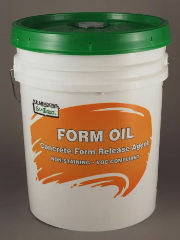 @Anonymous,
@Anonymous,
Thanks that's a helpful photo of concrete pour forms.
Consider that the forms are often coated (inner surface) with a release agent that makes it easier to pull the forms off of the concrete after the concrete has been placed, set, and cured enough.
Sometimes the release agent may leave stains or marks on the concrete too.
If the stains are a release agent, those are in essence an type of oil that can often be scrubbed off using a simple mix of dish detergent and water and a soft bristle brush. Don't try scrubbing new concrete before it's sufficiently hard as you could scuff up the surface.
Test some detergent scrubbing on a small unobtrusive area first.
There is a wide range of concrete form release agents and oils, some are water-based and are easier to clean-off.
Below we show just one example of many, from WR Meadows, a supplier of concrete form release agents.
See this
- CONCRETE FORM OIL DATA SHEET [PDF] (2018) R Meadows, 2150 Monroe Street, York, PA 17404 USA (the company has operations in other countries) Tel: (717) 792-2627 Web: https://www.wrmeadows.com/ E-mail: wrmpa@wrmeadows.comretrieved 2022/06/07, original source: https://www.wrmeadows.com/data/365.pdf
Excerpt: FORM OIL is composed of a high molecular weight, chemically inert ingredient to prevent the bonding of concrete to the form.
FORM OIL form release, when properly applied, is an inexpensive way to substantially reduce the potential creation of bug holes.
On 2022-06-07 by Anonymous
@Inspectapedia Com Moderator, The black staining does not come off with a clean paper towel or dry paper towel.
Concrete forms photo attached. Interestingly at another area on the same project, same process was used for formwork and stripping and the discolouration is no-where near as noticeable.
We believe this puts it down to two causes - time of the year it was poured, Darker stained area was December (summer in australia) while the lighter colour was australian winter.

On 2022-04-02 by Inspectapedia Com Moderator - using CLR is a Calcium-Lime-Rust remover on concrete stains
@Anonymous,
CLR is a Calcium-Lime-Rust remover. It's suitable for removing efflorescence: typically white stains and salts left behind from evaporating water on concrete or other masonry surfaces.
CLR is not likely to be the best choice for other types of concrete stains but certainly won't hurt the concrete if you want to give it a shot.
Muriatic acid and other acid cleaners are often used to remove concrete stains but must be used with great care to follow the manufacturer's instructions - acids are innately hazardous chemicals.
I'd like to know what that black staining actually is. Can you wipe it off at all using a clean dry paper towel? Or a wet paper towel? Let me know.
Above on this page we describe "black stains on concrete" that are not actually stains (from some external material or source) but may be moisture variations in the concrete.
So let's first understand more about what's on or in our concrete wall.
And also post photos, if you can, of the concrete forms used and find out what release agent was used to coat the form surfaces before the concrete was placed.
On 2022-04-02 by Anonymous
Hello,
Formwork has been left on for >14 days and the attached staining has appeared on concrete.
What is it and how can I get rid of it. Brand new plywood was used. I have read online potentially the use of CLR, acids etc?
On 2021-12-21 by Inspectapedia Com Moderator - efflorescence under carpet on concrete
@Mel,
That white powdery material is probably efflorescence
detailed at EFFLORESCENCE SALTS & WHITE DEPOSITS
Those dark straight-lined marks that seem to taper to a fading point are man-made, perhaps during construction as locator marks, and have nothing obvious to do with water entry (unless they point to a cut or hole or fastener location that might have made a perforation in the concrete).
On 2021-12-21 by Mel
We recently found a random wet area in our carpet in the dead center of our room with no leads to where it came from.
Even the plumber we called wasn't sure. My husband and I ripped up the carpet to try to find the source and we found some strange marks on the concrete underneath as well as some mildew underneath the carpet padding.
It looks like someone previously worked here as there's all kinds of tape and such under the carpet padding.We are most curious about these weird cross hatch markings that look burned onto the floor. There's a few sets of prints like the one in the picture I attached. Thank you!
On 2021-10-29 by (mod) - orange stains on concrete may be from rebar
@Josh,
Sure, there could have been rust lines from re-bar that traveled under the plastic, a plausible explanation.
To test that, try an iron-stain remover on a small area of one of the stains and let us know what happens.
The clay stains are a second possibility, though perhaps less likely if the plastic was new and if there wasn't red clay dust atop the new pour nor on the plastic just prior to rain.
At STAINS on BRICK SURFACES
we include an example of using an iron stain remover
On 2021-10-29 by Josh
@inspectapedia.com.moderator,
Thanks for the reply! This is showing up on a driveway and walkway pavers that we had poured, so will definitely be noticeable. We do have heavy clay in the the soil (Houston), and I was told the plastic was new but can't confirm.
They used rebar to hold down the plastic, but it was on the sides on top of the plastic, not directly laying on the concrete. Could rust have travelled along the plastic that contacted the ground? Have added another picture that may show a bit more of the site.
On 2021-10-28 by (mod)
@Josh,
If the concrete is to be covered with a finish surface such as tile or flooring, then those stains don't need to be removed.
With no information about your site or about possible contaminants it may have been on the covering plastic we can but guess as follows:
I haven't seen that exact combination of concrete stain color and pattern before.
But their linear nature could map areas where there were wrinkles in the covering plastic; such wrinkles in plastic over new concrete might collect or hold extra surface water in rainy weather, and if surface runoff included mud or fine soil particles (or other contaminants) that guess might be accurate.
Is there clay soil at and around your site?
Was the plastic covering new or had been used elsewhere before?
Before using an acid wash on the concrete, consider that any concrete discoloring or stain removal will be more effective if we correctly diagnose the cause of the stain or its constituents.
When the concrete has cured sufficiently that scrubbing won't damage its hardened surface, then try detergent and water, and you might try using an iron stain removing product.
Test on a small area of stain before going to the trouble of buying a lot of cleaning chemical or making a mess.
Keep us posted.
On 2021-10-27 by Josh
I had a pour done on Saturday. Light rain for about 15 minutes at the end of the pour, with 5 minutes of heavy rain. The contractors put plastic over the concrete and orange streaks have appeared after it has dried for a few days. The below pic was taken today (Wed). No one seems to know what caused this and are recommending an acid wash once it has cured for a couple of weeks. Has anyone on this board seen this before, have any recommendations?
On 2021-09-07 by (mod)
@Anonymous,
I'm not sure what we're debating here under the aegis of me trying to help you.
As you've never heard of applying stains to concrete deliberately, you may want to
see CONCRETE COLORING & POLISHING - how color is applied to concrete floors & other surfaces - where we describe that process.
My suggestion is that you're not likely to find a sufficiently close match to the reset of the concrete that such coloring is worth the trouble and cost. I named it for completeness.
Bottom line:
If as it appears you've lost the very top surface of the concrete then no further etching, cleaning, scrubbing, etc. is going to make it look like it used-to - or like the surrounding, intact concrete surface.
On 2021-09-07 by Anonymous
@inspectapedia.com.moderator,
In your last reply, you said, "there are, however, etching processes as well as bonding agents that might let you then try to coat the surface with portland or cement..."
Sorry, but I have no idea what you're talking about.
One can try applying to the slab an acid stain, a water based dye, or a pigmented sealer. These likely though will highlight the marks more than anything and not mask the spots.
In a earlier reply you said,
"There are cosmetic steps that might make that area look a little better, but in my opinion rather iffy, such as finding a concrete coating ...."
The only way to make the slab look cosmetically better to which you said would be "iffy", is to apply a micro-topping to start out new. I never heard of anyone ever applying stain, dye or adding a pigmented sealer before installing a microtopping. But that's what apparently it sounds like you stated if you read your entire reply.
On 2021-08-31 by (mod) - surface of concrete lost
@Jess,
It looks to me as if you've lost the high-portland-content skim coat that was on the surface of your concrete;
It's your concrete, and of course I'll be grateful to learn the results of any further experiments you try - that will help other readers.
But I'm doubtful that any further treatments that remove surface material will restore what has been lost; there are, however, etching processes as well as bonding agents that might let you then try to coat the surface with portland or cement that comes closer to the original color.
At the end of the day we're left with what is principally a cosmetic concern.
It looks as if wear from the furniture wheel has removed some of the concrete surface, leaving a darker substrate.
On 2021-08-31 by Jess
@inspectapedia.com.moderator,
Hello again. I apologize for asking this question.
But Is it possible that an application of 1.65% alkyl dimethyl benzyl ammonium chloride (Benzalkonium) could further cause more surface etching? In my estimation, this may be only option remaining to see whether I can lighten the darkened spots, at this stage.
Thank you in advance.
On 2021-08-31 by Jess
@inspectapedia.com.moderator,
I attached a closer photo along the edge of stain. the aggregate
This close-up along the side of the stain and the unaffected concrete does reveal some of the aggregate where the top most layer was removed. I wouldn't go so far as to say the entire surface area is etched as much as those areas revealing the aggregate.
For instance, the darkest discolored spots don't appear to have any surface removed.
(They do feel smoother than the untreated concrete, however. But basing the appearance of this photo to how it visually appeared last year to the naked eye, the darkest spots made up the entire stained area prior to the successful attempts to lighten it in 2020.
So I not completely convinced the darkest discolorations can't be lightened. The question is then how to accomplish that at this point without causing additional etching.
On 2021-08-31 by (mod)
@Jess,
One thought occurs to me that you might want to test.
It is possible that all of that cleaning in the stained-area, combined with the effects on the area of the original planter that sat there, actually has removed some of the original concrete surface - lighter colored material - leaving a darker, more-coarse concrete surface exposed.
Try taking a close-up macro type photo, very sharp and well lit, showing the edges of the stained area - and maybe try again with a magnifying glass.
That may tell us if I'm right.
If so, no amount of additional cleaning will make the stain go away, because it's not a stain, its lost surface material.
There are cosmetic steps that might make that area look a little better, but in my opinion rather iffy, such as finding a concrete coating or paint that's as close to the original surface as possible, or worse, painting the whole area - not something I'd recommend.
On 2021-08-31 by Jess
Last year I placed two potted planters on unsealed concrete at the front door entrance. The minerals from the fertilized soil, and probably also the clay pots caused black stains. The pots were removed three to four weeks after they were initially set down.
I tried scrubbing the black stains with water, mild soap plus ammonia, water, mild soap plus vinegar, and finally with a concrete and asphalt driveway cleaner (ZEP brand). The stains became a grey permanent stain.
I couldn’t fully remove them. As a final step, I sprayed the stains with Wet n Forget and stopped attempting to remove the stains for the remainder of the year. By the end of the year there was a small change where the stain was becoming lighter.
This year, I wanted to see if I could lighten the stains even more. I began spraying the stains in May with Wet n Forget and sprayed them several times up until this late August. I saw little marked improvement during this time period. I occasionally watered the stains with a garden hose to aid in the process during the dry summer months.
The following mistakes are those made to cause the stains to become much, much worse:
In late August of this year, I sprayed a 50:50 solution of 6% vinegar and water on the stains keeping the stains wet for approx. an hour. After the application time and as the solution dried, I saw no improvement.
I did notice that the vinegar and water solution slightly surface etched the stained concrete areas. I then made the mistake of not rinsing the concrete that same day to remove all of the vinegar solution from continuing to etch the concrete.
I also went further by applying a 2 part water to one part oxygen bleach mixture (sodium carbonate and sodium percarbonate) right after applying the vinegar and water solution. I lightly scrubbed the bleach mixture with a nylon brush and allowed it to sit for approx. 10 minutes.
After I flooded the concrete to rinse off the oxygen bleach and let the concrete dry, the stains went from light gray to black. How can this have occurred? I hastily went so far as to make yet another mistake by spraying a mixture of swimming pool algae guard containing active ingredient 15% concentrate alkyl dimethyl benzyl ammonium chloride after flushing the oxygen bleach with a garden hose.
The swimming pool algae product (brand name ‘Algae Guard’ by HTH) does not contain pool chlorine. I realized 45 minutes after applying the algae guard that I had made a dilution error.
The solution was too highly concentrated and the miscalculation allowed for a 14%. solution. The Wet-n-Forget ‘ready-to-use’ product is 1.65% alkyl dimethyl benzyl ammonium chloride (Benzalkonium) which is what I was shooting for. (formula (V1 *C1 = V2 * C2). The idea was basically to try to manufacture a home made concoction of Wet n Forget
After applying the highly concentrated algae guard and after it was allowed to dry, the black stains had now spread out even farther than the original stains. I flooded the concrete with buckets of hot water and then applied a box of baking soda to make a paste.
I lightly massaged the thick paste by hand and a nylon brush onto the larger stains. After approx. an hour, I flushed with a garden hose.
The following day, the two stains became much worse than ever before.
I was only able to attach one photo of one of the stains.
I was hoping I could correct these errors I made so at least the dark stains could be made a lighter gray (as they were last year). Sorry, I don't have any photos of how the stains looked before these mistakes were made.
Regards,
Jess
P.S. I no longer own a power washer.
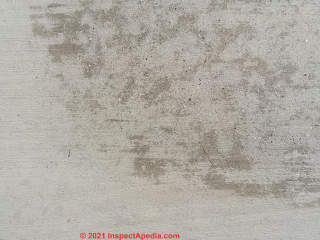
On 2021-02-10 by (mod)
I'm unsure, Todd,
Take a look at the common types of stains on concrete above;
Also look closely at the surface area of that dark spot: is the surface rough or spalled?
On 2021-02-10 by Todd K
Anyone know what this is? Covered patio. Slab is 12-14 Mo. old.
Thanks!
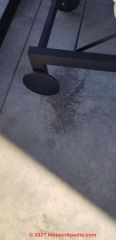
Question: how do I get rid of these stains on my concrete floor?
I live in an apartment and trying to identify a concrete stain so that I can properly clean it. It looks like a resident spilled something and didn’t really clean it up.
The spill didn’t seem so bad initially (it was kind of light brownish at first), but the stain has become darker and more noticeable.
Can anyone identify what the source is? Trying to determine whether the source was a health hazard so that I can clean it up appropriately.
Moderator reply:
@Mike Joseph,
I can't tell from your photo what those dark stains are; we'd need a sharper, closer look plus some understanding of the history of what's been on or near that floor section.
But see the help offered at
CONCRETE STAINS: ID & REMOVALinspectapedia.com/exterior/Concrete_Stains.php
where we discuss how to identify and thus treat various types of stains on concrete.
Or you can always try the experimental approach, starting with the safest, most-harmless cleaners such as
- dish soap
- TSP substitute cleaner
- concrete garage slab and driveway cleaner products
- concrete cleaning acids such as Muriatic
Watch out: Muriatic acid s a dangerous chemical that requires special procedures and handling for personal safety
Question: pink "efflorescence" on garage floor slab
I see efflorescence on my concrete garage floor. I also see some pink material as well.
Have you ever seen pink efflorescence? Or could it be mold? - Anonymous by private email 2019/09/22
Moderator reply:
Yes pink efflorescence salts (or red, brown, white, even green) can be deposited, depending on the composition of the masonry material that is suffering leakage or water exposure.
But there may be other sources of pink on a garage floor such as from antifreeze or transmission fluid leaks too, or even bacterial action on an organic spill.
Reader follow-up:
It is just regular poured concrete and I never noticed the pink before, just the white efflorescence. So probably not mold?
Moderator reply:
I can't say for sure from just a sort-of blurry photo; there are red or pink molds and yeasts, and there are molds that will grow on just about anything, including perhaps dirty or dusty concrete walls;
Let's follow the water first.
On 2020-07-10 - by (mod) - diagnose & cure dark mottled, blotchy, or water run-down stains on interior concrete wall
I agree that the stains on your concrete walls may be an artifact from original forms work and construction. If so they're not harmful and are only a cosmetic issue.
You will see other examples of similar un-invited stains on concrete
at CONCRETE STAINS: ID & REMOVAL where I will post and hope we can continue this discussion.
As with many building and environmental questions, we will have better success if we understand the problem before posting a solution.
FIRST:
Let's be sure we're correct about the wall materials and that we understand how, when and how it was constructed. .
Is this wall really solid poured concrete?
Is this wall plaster on a wood or steel-framed cavity wall?
Is this wall cement board or plastered gypsum board on a cavity wall or over a masonry wall?
What is the type of construction of the building.
Where is the building: country and city?
What is the building age?
What is the building's leak history?
SECOND:
Dark mottled and rivulet or down-run stains on a concrete wall may be due to water intrusion or water condensation or even an artifact of the concrete pour and the forms used.
Some discolorations in concrete, including dark areas, are natural, not harmful, and are not economical, if even possible, to remove.
If the owner has cleaned the wall surface there's not likely to be mold on that surface.
If stains are embedded in the wall they're probably not going to be removed.
Some of the wall stains in your photos look like water tracking down the wall.
If there is water entry through the wall the source needs to be found and fixed.
When the wall is dry, not leaking, and stable, if you object to its colors and appearance it can be painted or stained with a product designed for use on concrete.
On 2020-07-10 by Janice
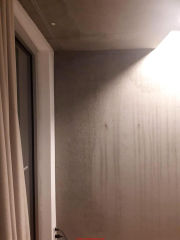 How would you go on to remove these stains or molds?
How would you go on to remove these stains or molds?
Is it possible to remove them without professional help in your opinion? The owner cleaned the area with H2O2 cleaner, but didn't remove the mold properly before. Is bleach and or TSP adivsible?
Thank you for your previous answer!
Also, I saw pegs sticking out the wall now, they probably got pushed out by moisture, since they were not visible before and were under paint/ concrete. I don't know a whole lot on construction work.
Might this be from construction for pouring the concrete or could that be a professional mold cleaning procedure from a previous attempt of removing molds in this appartment?
Or those are just pegs from holding something in the wall. (see photo, black spots are pegs with darker stain around them)
These stripes in the previous picture seem that liquid was dripping down, i think this damage was done by too much humidity without venting, but it might also come from outside?
I advised that the resident should contact the landlord, but she is afraid of the cost implications that this will produce, since most likely she will be held accountable at least to some degree because of insufficient venting.
Reader Question: what are the different concrete stains & markings shown in these photographs?
Please offer me your expert opinion on what is going on with my structural walls. I am working on a project located on Eko Atlantic Lagos Nigeria. And despite all our efforts we keep getting bug holes as shown below. C.I., Nigeria, 7/2/2014
Reply: a catalog of concrete surface markings & stains
I'll be glad to try to assist, with the warning that I am not a concrete engineer, though I do have experience in the subject.
Commenting on your photos in order [Click to enlarge any image]
1. Your photograph of "bug holes" in the concrete wall photo above look to me like small voids due to air bubbles in the concrete pour, probably due to poor mixing;
On larger & commercial concrete placement projects concrete contractors use a vibrator to remove these bubbles and avoid the voids.
In my photograph below, taken at the Vassar College building project in New York in 2014 you can see workers using the vibration tool as a large floor slab is being poured.
Only if these "bug holes" are in very great number would one expect there to be a structural concern. I can't evaluate that from a photo - you'd need an onsite expert. Usually for an important pour of structural concrete an expert checks the mix and the slump and the placement of reinforcing steel.
It's worth noting that entrained air has been intentionally included in some concrete placement operations for a very long time as a partial protection against freezing effects, salt scaling and other forces, as described in these research citations where proper air entrainment procedures are explained.
As you'll see in our citations given below, Powers (1969) has written extensively on this topic.
2.Photograph of holes & chip marks in a concrete wall (above) looks like chipping or spalling where concrete form ties were removed (cosmetic)
3. Photograph of the dark horizontal lines in a concrete wall (photo above) look like concrete form ties; the horizontal lines seem to mark boards used for the concrete forms
. I suspect that moisture variations during wall curing or possibly accumulation of water in irregularities in the form-wall caused the darkness.
The rippled surface in the lower right corner of the photo above (enlarged just below) suggests the mix contained excessive water or that plastic had been placed against the inner surface of the concrete form, but that's just an OPINION and we'll be interested to see what some of our readers who are concrete experts can offer.
4. & 5. Photographs of dark lines and blotchy areas in the concrete walls in the two photographs below look like cold pour joints in the concrete wall.
In your last photo (below left) we see both cold pour joints and rough surface areas or surface voids in the poured wall as well as holes (in both photos) from form ties.
Concrete Stains from Rusting Inclusions or Exfoliating Steel
The lower photo also includes reddish stains that may be rust from either metal forms or from iron slag inclusions in the concrete mix.
See details about cold pour joints found
If you give permission for me to publish these photos I may be able to solicit more expert opinions for you - I can keep your identity information private or can publish it with your contact information - which ever you prefer.- DF
Reader follow-up:
You reflected my thoughts as well. Thanks for the link on concrete cold pour joints it was insightful.
You have my permission to publish these photos though I think your observation is spot on.
And I look forward to reading what anyone else has to say.
Below are a concrete batch report and a sketch of the concrete wall plan for our project.
[Click to enlarge any image]
...
Continue reading at CONCRETE COLORING & POLISHING - procedures for deliberately coloring or staining concrete, or select a topic from the closely-related articles below, or see the complete ARTICLE INDEX.
Or see CONCRETE STAIN CAUSE & CURE FAQs - questions and answers posted originally on this page.
Or see these
Recommended Articles
- CONCRETE COLORING & POLISHING - how color is applied to concrete floors & other surfaces
- CONCRETE DELIVERY & MIXING
- CONCRETE FOUNDATION, WALL, SLAB DEFECTS
- CONCRETE STAINS: ID & REMOVAL - un-wanted stains or defects or discoloration
- EFFLORESCENCE & BROWN DEPOSITS
- GRAFFITI REMOVAL FROM BRICK CONCRETE STONE SURFACES
- FLOOR, CONCRETE SLAB CHOICES
- FLOOR, CONCRETE SLAB POURED FINISH
- FLOOR TILE INSTALL on CONCRETE
- POOL CONCRETE COOL DECK SURFACES
- RADIANT SLAB FLOORING CHOICES
- STAIN DIAGNOSIS on BUILDING EXTERIORS - including concrete
- STAIN DIAGNOSIS on BUILDING INTERIORS - including concrete
- STAINS on INDOOR SURFACES, PHOTO GUIDE
- STAINS on STONE, STUCCO DIAGNOSE & CURE for cleaning methods
- STAMPED CONCRETE CLEANING
Suggested citation for this web page
CONCRETE STAINS: ID & REMOVAL at InspectApedia.com - online encyclopedia of building & environmental inspection, testing, diagnosis, repair, & problem prevention advice.
Or see this
INDEX to RELATED ARTICLES: ARTICLE INDEX to BUILDING STAINS
Or use the SEARCH BOX found below to Ask a Question or Search InspectApedia
Ask a Question or Search InspectApedia
Try the search box just below, or if you prefer, post a question or comment in the Comments box below and we will respond promptly.
Search the InspectApedia website
Note: appearance of your Comment below may be delayed: if your comment contains an image, photograph, web link, or text that looks to the software as if it might be a web link, your posting will appear after it has been approved by a moderator. Apologies for the delay.
Only one image can be added per comment but you can post as many comments, and therefore images, as you like.
You will not receive a notification when a response to your question has been posted.
Please bookmark this page to make it easy for you to check back for our response.
IF above you see "Comment Form is loading comments..." then COMMENT BOX - countable.ca / bawkbox.com IS NOT WORKING.
In any case you are welcome to send an email directly to us at InspectApedia.com at editor@inspectApedia.com
We'll reply to you directly. Please help us help you by noting, in your email, the URL of the InspectApedia page where you wanted to comment.
Citations & References
In addition to any citations in the article above, a full list is available on request.
- In addition to citations & references found in this article, see the research citations given at the end of the related articles found at our suggested
CONTINUE READING or RECOMMENDED ARTICLES.
- Carson, Dunlop & Associates Ltd., 120 Carlton Street Suite 407, Toronto ON M5A 4K2. Tel: (416) 964-9415 1-800-268-7070 Email: info@carsondunlop.com. Alan Carson is a past president of ASHI, the American Society of Home Inspectors.
Thanks to Alan Carson and Bob Dunlop, for permission for InspectAPedia to use text excerpts from The HOME REFERENCE BOOK - the Encyclopedia of Homes and to use illustrations from The ILLUSTRATED HOME .
Carson Dunlop Associates provides extensive home inspection education and report writing material. In gratitude we provide links to tsome Carson Dunlop Associates products and services.


